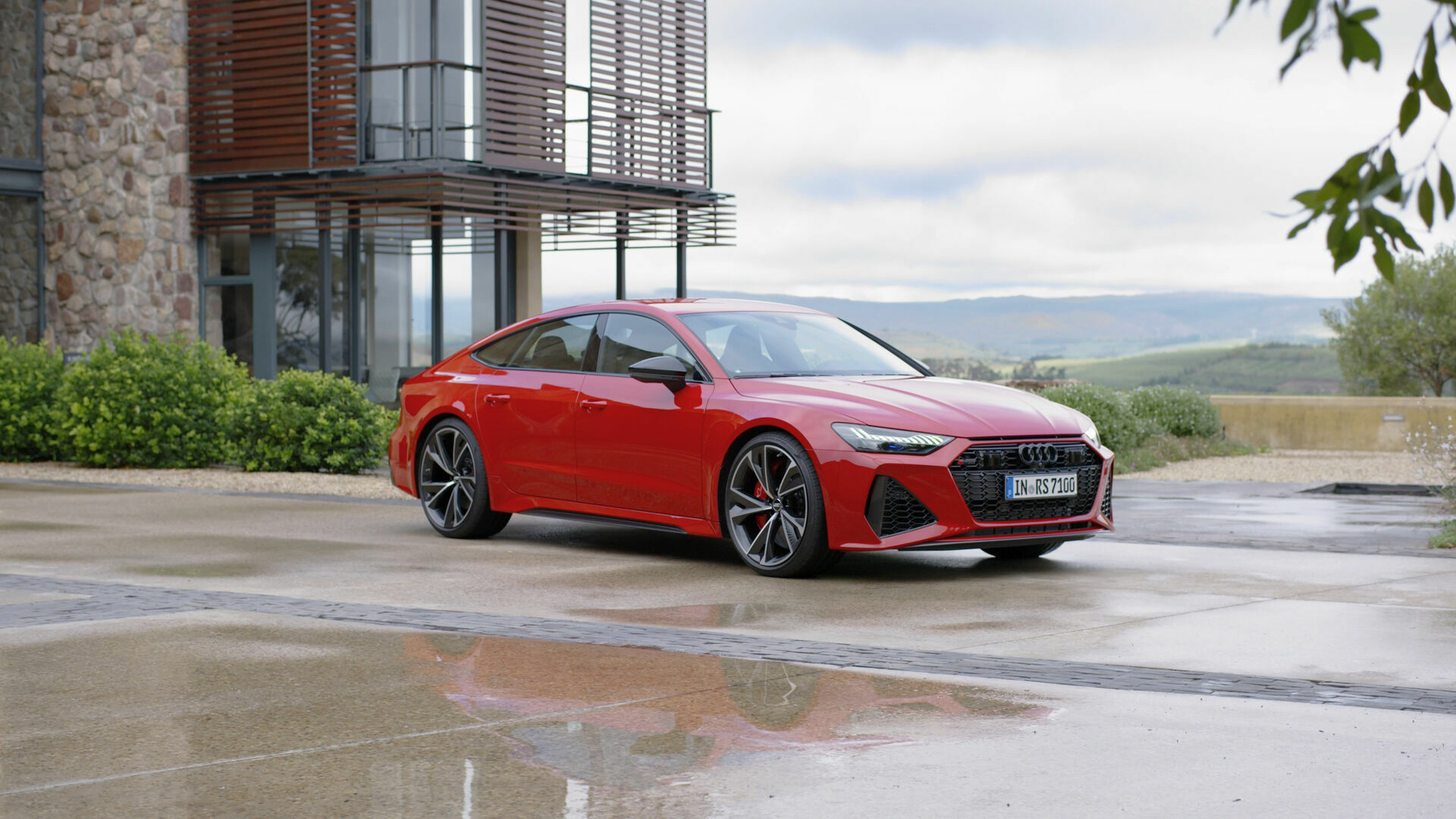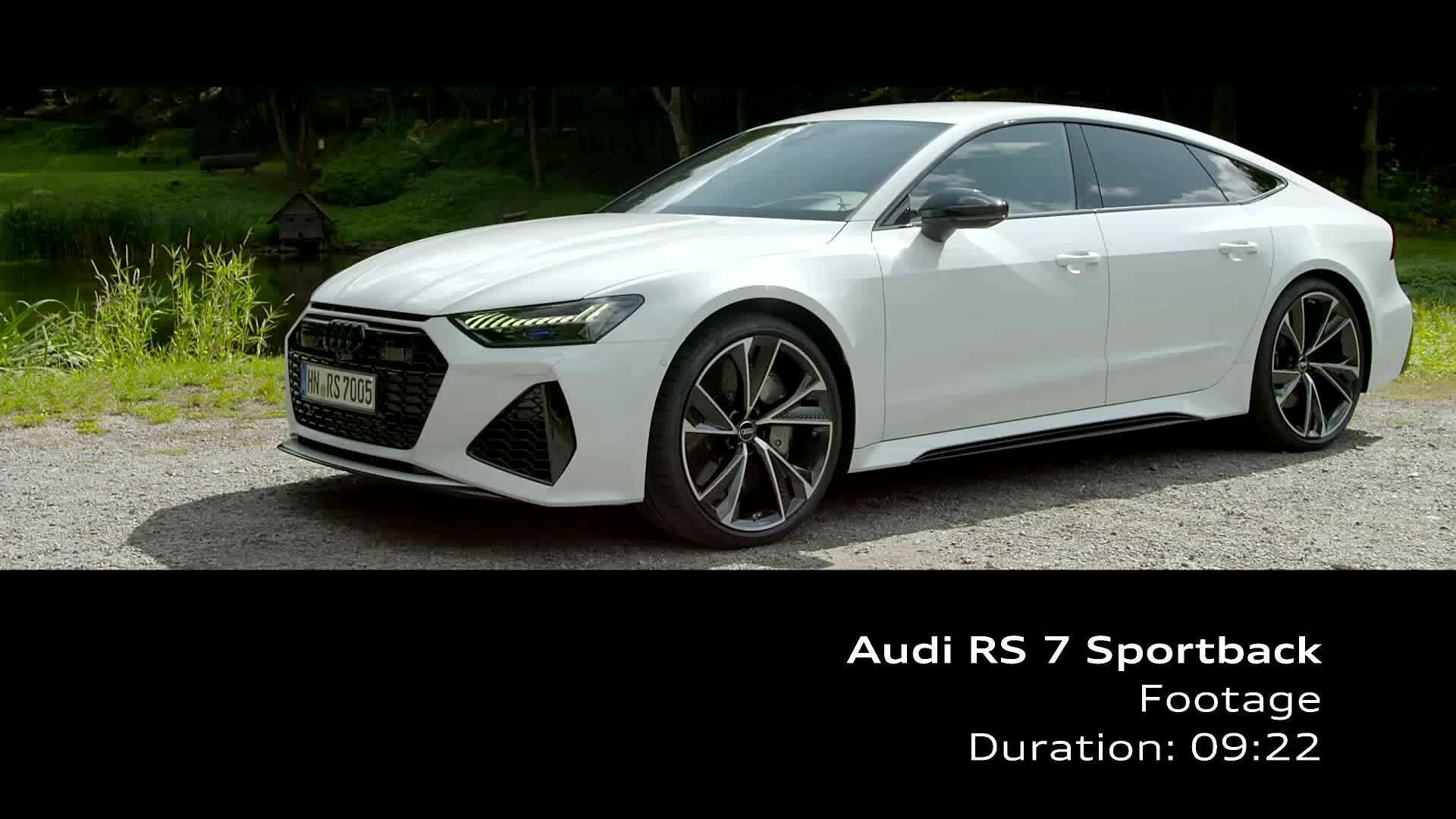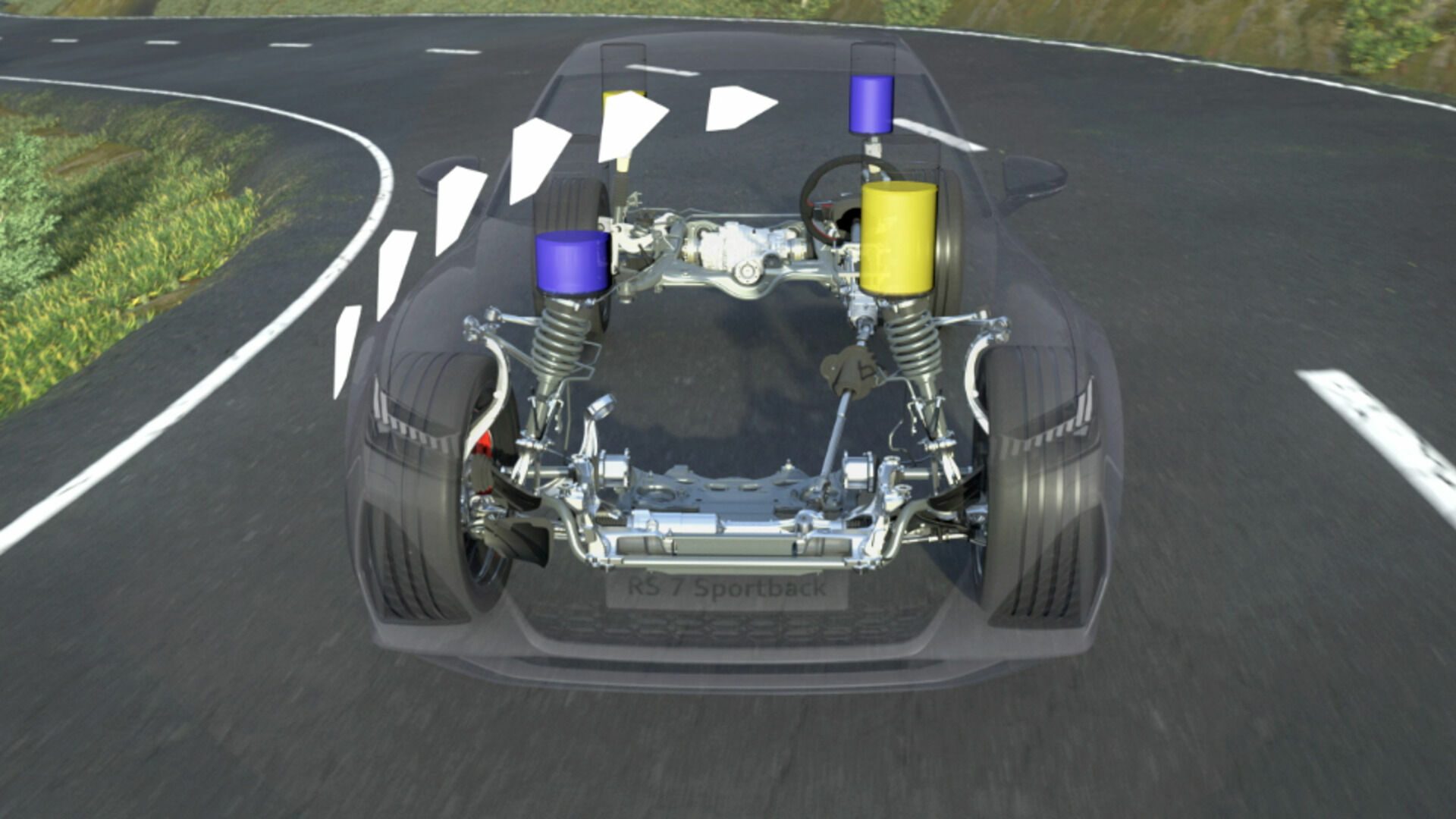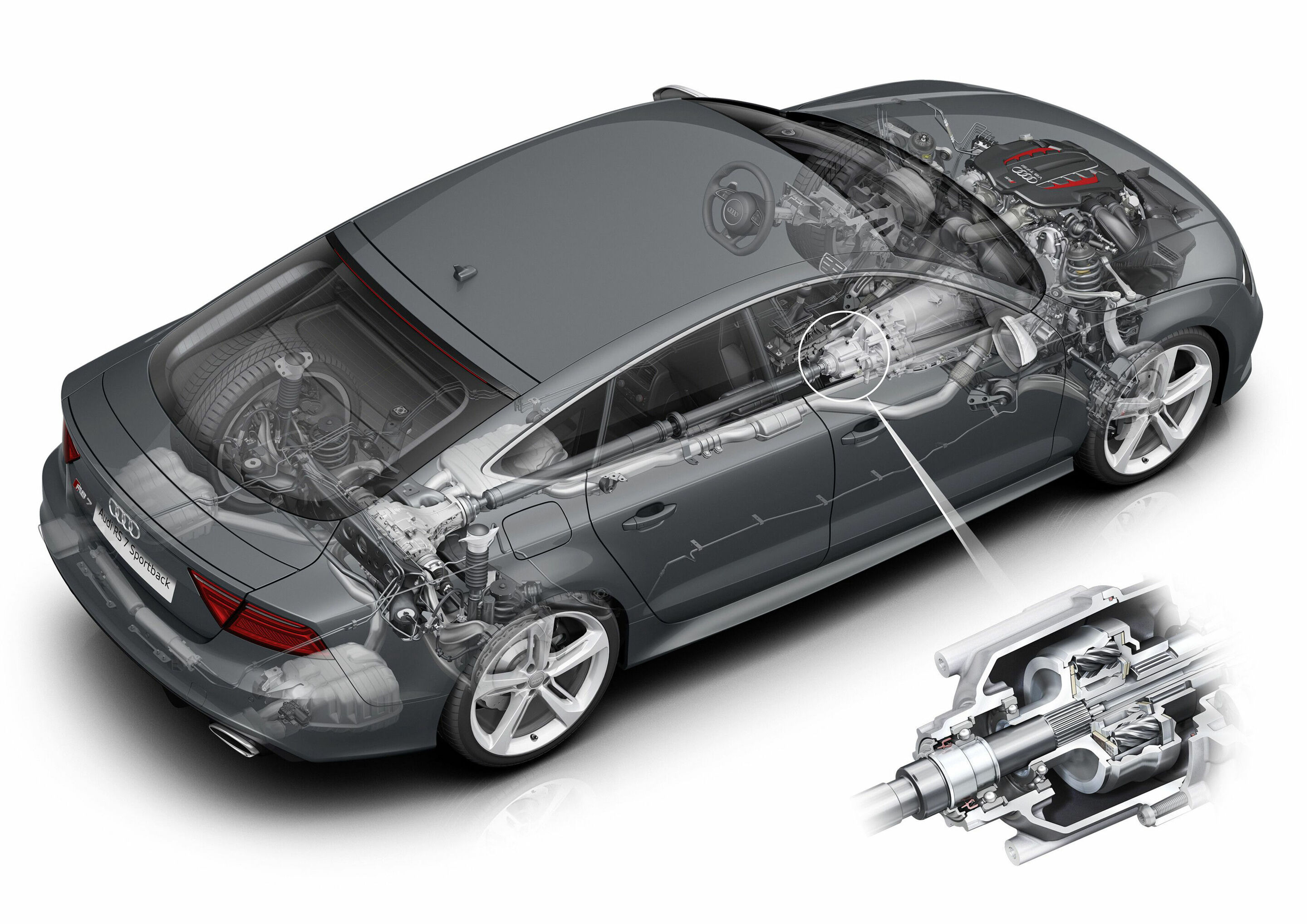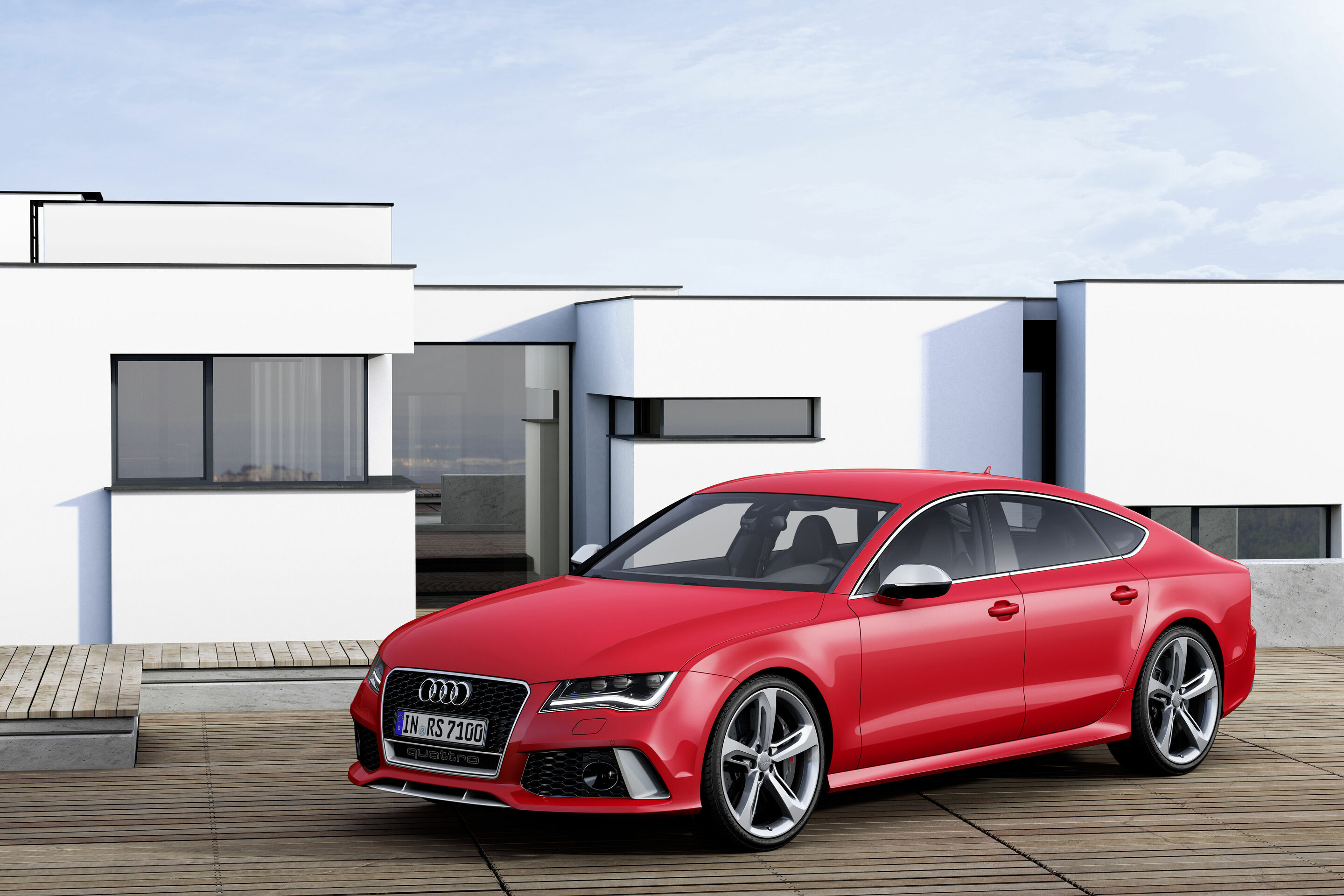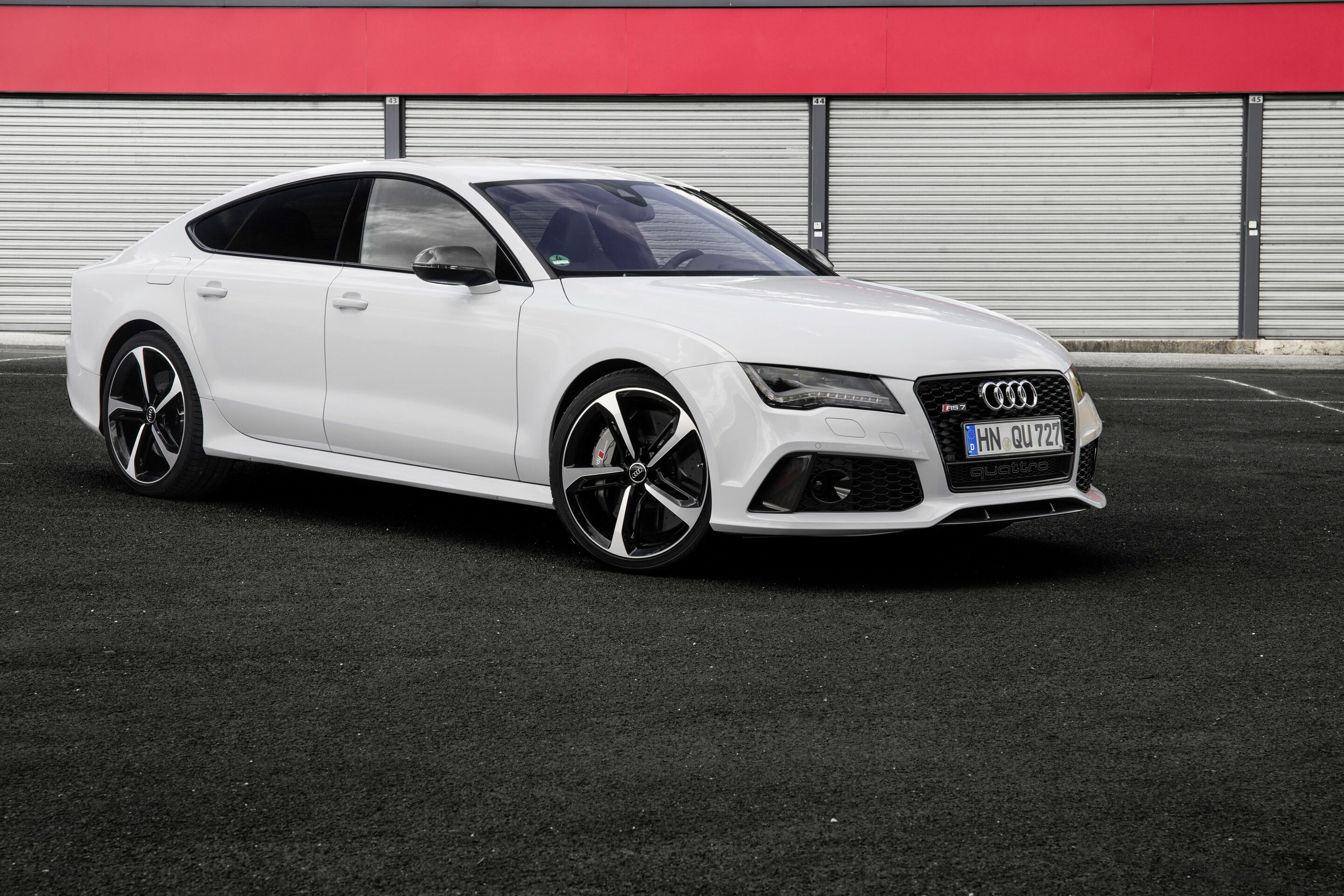Search
All search results for "Audi RS7"
(110)

Audi RS 7 Sportback (until 2025)
The second generation of the Audi RS 7 Sportback is more distinct than ever. Audi Sport GmbH pairs the standard athletic proportions with a wide body to create a look that does justice to the 4.0-liter V8 biturbo TFSI engine in every way. Bringing together the qualities of a Coupé, Sedan, and Avant, the RS 7 Sportback delivers 630 PS and 850 Nm in its most powerful configuration - the RS 7 performance.
Images Audi RS 7 Sportback (until 2025)
Videos Audi RS 7 Sportback (until 2025)
Engine type V8 engine
Displacement in cc / bore x stroke in mm / compression 3996 / 86.0 x 86.0 / 9.7
Max. power output in kW (PS) / at rpm 463 (630) / 6000
Max. torque in Nm (lb-ft) / at rpm 850 (626.9) / 2300 - 4500
Top speed in km/h (mph) 280 (174.0) (governed)
Acceleration, 0-100 km/h (0-62.1 mph) 3.4
Fuel consumption, combined in l/100 km (US mpg) 12.6 - 12.1 (18.7 - 19.4)
CO2 emissions, combined in g/km (g/mi) 285 - 274 (458.7 - 441.0)
CO2 class G
Unladen weight without driver / with driver / gross weight limit in kg (lb) 2065 (4552.5) / 2140 (4717.9) / 2735 (6029.6)
Engine type V8 engine
Displacement in cc / bore x stroke in mm / compression 3996 / 86.0 x 86.0 / 10.0
Max. power output in kW (PS) / at rpm 441 (600) / 6000 - 6250
Max. torque in Nm (lb-ft) / at rpm 800 (590.0) / 2050 - 4500
Top speed in km/h (mph) 250 (155.3) (governed)
Acceleration, 0-100 km/h (0-62.1 mph) 3.6
Fuel consumption, combined in l/100 km (US mpg) 12.6 - 12.0 (18.7 - 19.6)
CO2 emissions, combined in g/km (g/mi) 285 - 272 (458.7 - 437.7)
CO2 class G
Unladen weight without driver / with driver / gross weight limit in kg (lb) 2075 (4574.6) / 2150 (4739.9) / 2735 (6029.6)

Audi S7 Sportback TDI (until 2025)
Sportiness meets efficiency – the new Audi S7 Sportback make its entrance with a torquey V6 TDI engine, offering customers in Europe the ideal performance model for the long haul. For the first time, Audi has combined an electric powered compressor with a 48-volt primary electrical system. The S sport suspension with damping control, dynamic all-wheel steering and the ceramic brake system tick all the boxes for dynamic cornering and deceleration. The striking design with the sophisticated looks of an S model lends this sporty full-size model particular presence.
Images Audi RS 7 Sportback (until 2025)
Video Audi RS 7 Sportback (until 2025)
Engine type V6 engine
Displacement in cc / bore x stroke in mm / compression 2967 / 83.0 x 91.4 / 16.3
Max. power output in kW (PS) / at rpm 253 (344) / 3850 - 4000
Max. torque in Nm (lb-ft) / at rpm 700 (516.3) / 1750 - 3250
Top speed in km/h (mph) 250 (155.3) (governed)
Acceleration, 0-100 km/h (0-62.1 mph) 5.1
Fuel consumption, combined in l/100 km (US mpg) 7.4 - 7.1 (31.8 - 33.1)
CO2 emissions, combined in g/km (g/mi) 194 - 186 (312.2 - 299.3)
CO2 class G
Unladen weight without driver / with driver / gross weight limit in kg (lb) 2010 (4431.3) / 2085 (4596.6) / 2635 (5809.2)

With the Audi RS 7 Sportback and Audi RS 7 Sportback performance Audi Sport has produced an innovative sedan with a coupé-like grand tourer design. The four-door high-performance model offers a design all its own and a twin-turbo V8 with improved performance and enhanced efficiency thanks to its mild-hybrid system. As a five-seater, the RS 7 Sportback takes all-rounder capabilities to the next level.
 Dimensions RS 7 Sportback
Dimensions RS 7 Sportback
Audi RS 7 Sportback Abmessungen Dimensions 09/19 2 1 * maximaler Kopfraum / Maximum headroom Angaben in Millimeter / Dimensions in millimeters Angabe der Abmessungen bei Fahrzeugleergewicht / Dimensions of vehicle unloaded 1 Breite Schulterraum / Shoulder width 2 Breite Ellbogenraum / Elbow width 1 4 2 4 1668 1950 1650 10 26 * 94 9 960 2118 958 2930 1 5 2 5 1 4 5 3 2 1 1 4 9 0 1 4 2 1 1121 1175 1 0 5 0 6 4 7 5009
 RS 7 Sportback (until 2025) TFSI (441 kW)
RS 7 Sportback (until 2025) TFSI (441 kW)
Program for Germany, Status: 06/13/2024 1/2 Audi RS 7 Sportback TFSI Engine / electrics Engine type V8 engine Valve gear / number of valves per cylinder Roller cam follower, continuous intake and exhaust camshaft adjustment, hydraulic valveplay compensation / 2/2 inlet/exhaust valves per cylinder Displacement in cc / bore x stroke in mm / compression 3996 / 86.0 x 86.0 / 9.7 Max. power output in kW (PS) / at rpm 441 (600) / 6000 - 6250 Max. torque in Nm (lb-ft) / at rpm 800 (590.0) / 2050 - 4500 Mixture preparation Direct injection, lambda control, knock control, turbocharger, intercooler Exhaust emission control Catalytic converter, oxygen sensor, gasoline particulate filter Emission standard Euro 6e On-board voltage 1 in volts 12 On-board voltage 2 in volts 48 Drivetrain / transmission Drive type quattro permanent all-wheel drive with self-locking center differential Type of rear axle differential Standard Clutch Hydraulic torque converter with lock-up clutch Transmission type 8-speed tiptronic Transmission ratio in 1st/2nd gear 4.714 / 3.143 Transmission ratio in 3rd/4th gear 2.106 / 1.667 Transmission ratio in 5th/6th gear 1.285 / 1.000 Transmission ratio in 7th/8th gear 0.839 / 0.667 Reverse gear ratio / final drive ratio 1-2 / 2-3 -3.317 / 3.204 / - Suspension / steering / brakes Type and design of front-axle suspension 5-link front axle Type and design of rear-axle suspension 5-link rear axle Tires (basic) 275 / 35 ZR 21 Wheels (basic) Cast aluminum 10.5 J x 21 Steering Electromechanical progressive steering with speed-dependent power assistance Steering ratio 15.8 Turning circle in m (ft) 12.2 (40.0) Brake system ESC/ABS/EBD, brake booster, hydraulic brake assist; Front: aluminum fixed calipers; Rear: aluminum fixed calipers Brake disk diameter front / rear in mm (in) 420 (16.5) / 370 (14.6) Performance / fuel Top speed in km/h (mph) 250 (155.3) (governed) Acceleration, 0-100 km/h (0-62.1 mph) 3.6 Fuel type / octane value / fuel standard Gasoline / 98 / DIN EN
 RS 7 Sportback (until 2025) performance TFSI (463 kW)
RS 7 Sportback (until 2025) performance TFSI (463 kW)
Program for Germany, Status: 06/13/2024 1/2 Audi RS 7 Sportback performance Engine / electrics Engine type V8 engine Valve gear / number of valves per cylinder Roller cam follower, continuous intake and exhaust camshaft adjustment, hydraulic valveplay compensation / 2/2 inlet/exhaust valves per cylinder Displacement in cc / bore x stroke in mm / compression 3996 / 86.0 x 86.0 / 9.7 Max. power output in kW (PS) / at rpm 463 (630) / 6000 Max. torque in Nm (lb-ft) / at rpm 850 (626.9) / 2300 - 4500 Mixture preparation Direct injection, lambda control, knock control, turbocharger, intercooler Exhaust emission control Catalytic converter, oxygen sensor, gasoline particulate filter Emission standard Euro 6e Max. electrical output at 12V in kW 3 On-board voltage 1 in volts 12 On-board voltage 2 in volts 48 Drivetrain / transmission Drive type quattro permanent all-wheel drive with self-locking center differential Type of rear axle differential Standard Clutch Hydraulic torque converter with lock-up clutch Transmission type 8-speed tiptronic Transmission ratio in 1st/2nd gear 4.714 / 3.143 Transmission ratio in 3rd/4th gear 2.106 / 1.667 Transmission ratio in 5th/6th gear 1.285 / 1.000 Transmission ratio in 7th/8th gear 0.839 / 0.667 Reverse gear ratio / final drive ratio 1-2 / 2-3 -3.317 / 3.204 / - Suspension / steering / brakes Type and design of front-axle suspension 5-link front axle Type and design of rear-axle suspension 5-link rear axle Tires (basic) 275 / 35 ZR 21 Wheels (basic) Cast aluminum 10.5 J x 21 Steering Electromechanical progressive steering with speed-dependent power assistance Steering ratio 15.8 Turning circle in m (ft) 12.2 (40.0) Brake system ESC/ABS/EBD, brake booster, hydraulic brake assist; Front: aluminum fixed calipers; Rear: floating calipers with integrated electronic parking brake Brake disk diameter front / rear in mm (in) 420 (16.5) / 370 (14.6) Performance / fuel Top speed in km/h (mph) 280 (174.0) (governed) Acceleration, 0-100 km/h (0-62.1

More powerful and faster than any RS 7 to date, the new Audi RS 7 Sportback performance is bursting with extras that sharpen the models’ appearance and make for a more emotive driving experience. The potent 4.0-liter V8 biturbo TFSI engine now has an engine power of 463 kW (630 PS) and a maximum torque of 850 Nm. At Audi, “performance” means more power. Larger turbochargers and an increase in boost pressure from 2.4 to 2.6 bar in the 4.0-liter V8 biturbo TFSI engine of the RS 7 Sportback performance allow an increase of 30 PS in engine power and 50 Nm more torque compared to the base version. This means total power rises from 441 kW (600 PS) to 463 kW (630 PS) and maximum torque rises from 800 to 850 Nm (590 to 627 lb-ft). The performance model sprint from 0 to 100 km/h (0 to 62.1 mph) in 3.4 seconds, 0.2 seconds faster than the RS 7 base version. Less is sometimes more: Reduced insulation between the engine compartment, the interior, and the rear of the vehicle ensures the RS 7 Sportback performance will thrill customers with an exciting, next-level sound experience – the reduction also makes the car eight kilograms (17.6 lbs) lighter.
 Strong Audi showing in DTM finale
Strong Audi showing in DTM finale
Three Audi RS 5 DTM cars in the best three grid positions Audi RS 7 to do a fast lap at Hockenheim – without a driver World premiere of the new Audi Sport TT Cup
Strong showing by the four rings in the DTM finale at Hockenheim (Sunday live on ‘Das Erste’ starting 13.30): Miguel Molina, Mattias Ekström and Edoardo Mortara secured the best three grid positions for Audi for the last race of the year. Six Audi RS 5 DTM cars in total made it into the top eight in qualifying. Before the race starts, a driverless Audi RS 7 and the new Audi TT cup will be making a grand appearance as well.
It was a qualifying session exactly to the liking of Dieter Gass, Head of DTM at Audi Sport: “Six Audi cars in Q3 and three in the top three positions of the grid: That was precisely the strong showing we needed here in qualifying. I can only tell the whole squad: well done! If we repeat this performance tomorrow in the race, then we’ll have very good chances of winning the manufacturers’ title. That’s clearly our aim.” Miguel Molina in the Audi Sport Audi RS 5 DTM of Audi Sport Team Abt Sportsline decided the battle for the best grid position in his favor. The Spaniard defeated his team-mate Mattias Ekström in the Red Bull Audi RS 5 DTM by a razor-thin margin of 16 thousandths of a second. Edoardo Mortara in the Audi Sport Audi RS 5 DTM in third place completed the strong showing by the Bavarian squad. “I’d like to thank Audi and my team who worked hard for this result. And this work has paid off,” said Miguel Molina, who secured the best grid position for the third time in his DTM career. “The pole position is fantastic and the whole result is great for Audi. The last races didn’t go so well for me, but now we’re at the very front again.” Jamie Green in the Hoffmann Group Audi RS 5 DTM of Audi Sport Team Rosberg secured grid position five.
